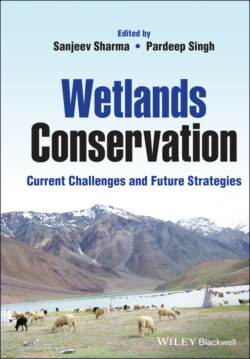Читать книгу Wetlands Conservation - Группа авторов - Страница 13
1.1.1 Wetlands‐ Categorization and Classification
ОглавлениеDifferent types of wetlands have some common characteristics like:
1 Hydrology that causes wet or flooded soils
2 Soils influenced by anaerobic processes and
3 Life forms, especially rooted vascular plants, adapted to life in flooded ecosystems
There are many wetlands habitats, including human constructed and natural reservoirs and ponds, paddy fields, marshy and swampy lands.
The most important primary productive ecosystem in the world are marshes and swamps. They are recharged naturally by the availability of water sources and different forms of precipitation.
Marshes are dominated by herbaceous vegetation and non‐wooded wetlands while swamps are dominated by woody plants and trees.
The subtypes of marshes and swamps are:
1 Tidal Marshes: Tidal marshes are commonly found near the shorelines and have high salt content. They sequester millions of tonnes of carbon every year. Major tidal marshes are existing in Eastern North America and Coastal Europe.
2 Freshwater Marshes: The freshwater marshes account for more than 90% of the wetland area in the U.S. Florida Everglades is one of the world's most extensive marshes.
3 Swamps are found in still water areas and around floodplains. They include forested systems, the herbaceous systems and the Papyrus systems.
4 Mangrove: The World's Mangrove Swamp forest‐covered around 14 million hectares by the end of the 20th century. Majority of mangroves are existing in the economically impoverished regions of the world. These regions are mainly around the Indian Ocean, West Pacific region, Niger and the Sunderban Deltas.
5 Peatlands: Peatlands can be marshes or swamps, depending upon the vegetation. Bogs are nutrient‐poor peatlands since they are isolated from the groundwater. Whereas fens are peatlands rich in nutrients as they receive inputs from the groundwater. Peatlands covered at least 500 million hectares including bog, moor, fen, muskeg are some landscapes formed by peats.
6 Peat soil: Peat soil is concentrated in the Yellow sea region. They occupy 3% of the land surface and store large carbon sink (Ramsar Convention on Wetlands 2018).
The most generally recognised classification system for wetlands has been devised by the Convention on Wetlands of International Significance (Ramsar Convention). This classification method splits wetlands into three main groups (i.e. marine, inlands and human‐ made), divided into 42 types of wetlands and summarized in Table 1.1. The codes approved by Recommendation 4.7 and modified by Resolutions VI.5 and VII.11 of the Contracting Parties Conference would represent different types of wetlands. This classification aims to provide a detailed framework to encourage the rapid identification of the key wetland ecosystems at each location (Ramsar Convention Bureau, 2010; website‐Department of Agriculture, Water and the Environment, Southern Australia)
